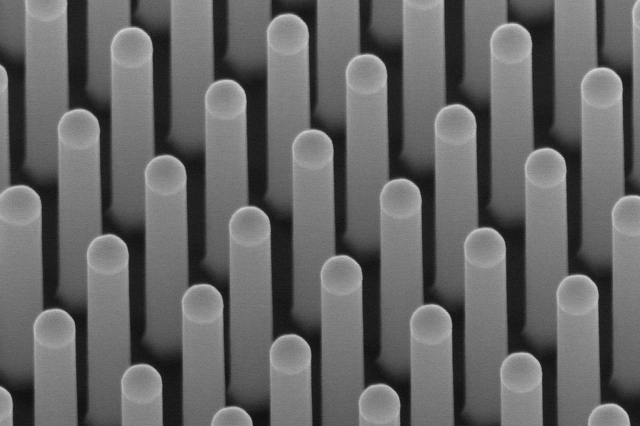
In the continuing quest to create solar cells, researchers seek new materials, use clever techniques, and look for novel physical phenomena to extract the maximum electricity out of sunlight for the lowest cost. One method of extracting more power at a lower cost relies on creating arrays of nanowires that stand vertically on inexpensive substrates. In contrast to the material in ordinary solar cells, nanowires use less material, can potentially be built with less costly materials, and in principle trap more light thanks to the geometry of the arrays. However, most nanowire solar cells are currently outperformed by their conventional counterparts.
A new effort used indium phosphide (InP) nanowires with diameters smaller than the wavelength of the light they were trapping. That trick enabled Jesper Wallentin and colleagues to reach comparable efficiencies and slightly higher voltage than a conventional InP solar cell. While the wires only covered 12 percent of the surface area, they exploited a principle known as resonant trapping to extract over half as much current as a full planar cell of InP. This approach could lead to even greater efficiency at lower cost for solar cells.
Many candidates for the next generation of photovoltaic (PV) solar cells are being investigated. Research in this area has two goals that don't always overlap: maximizing the efficiency of converting sunlight into electric current, and reducing cost per unit of electricity. The advantage of nanowire-based cells lies in using a lot less material, since the entire surface need not be covered in PV material. Additionally, the wires themselves can be fabricated from relatively inexpensive semiconductor materials.
While planar solar cells—the ones most of us think of when we think solar panels—coat as much of the available surface as possible, nanowire-based cells are like brushes with microscopic bristles. The efficiency and current of the PV depends on the diameter of the wires, and how densely they are packed on the surface.
However, many nanowire cells have been hampered by low efficiency compared with planar PVs. The authors of the present study argued that this is partly because nanowire surfaces are prone to defects that prevent efficient light conversion. Since a thin wire has a large surface compared to its volume, this problem can be fatal to performance. (Similar problems plague pit-based PV cells; see my earlier article on a possible way to circumvent that issue.) These previous experiments largely used wires with relatively large diameters and focused on covering as much of the available surface as possible.
In the new study, the researchers determined that two major factors dictated optimal performance: the diameter of the wire, and the conductive properties of the InP. From theoretical predictions, wires with diameters significantly less than visible-light wavelengths achieve resonance when the light strikes, vastly increasing the amount of energy that can be absorbed. The new model suggested peak efficiency would be reached with an nanowire diameter of 180 nanometers. (Visible-light wavelengths are roughly 400 to 700 nanometers.)
Indium phosphide is a semiconductor, meaning that under ordinary conditions the material acts as an insulator. By adding atoms of another element to the crystal lattice—a process called doping—the material's conductive properties can be manipulated. The InP nanowires in the present study made a sandwich: two types of doping, with undoped semiconductor in between. The researchers found that the thickness of the topmost doped layer made the greatest difference to light absorption.
The researchers more than doubled the efficiency of previous nanowire cells, from 5 percent to 13.8 percent at peak performance. Planar InP solar cells have reached 22.1 percent efficiency, but the nanowire cells covered only 12 percent of the area—a significant reduction in material used. Additionally, they achieved comprable density of current and higher peak voltage compared to planar PV cells.
The nanowire cell still did not outperform conventional PVs in most respects, but the substantial improvement over previous nanowire designs points toward even greater advances in the future. The use of far less material than planar PVs based on InP also means a potential reduction in cost per unit of electricity.
Science, 2013. DOI: 10.1126/science.1230969 (About DOIs).
reader comments
31